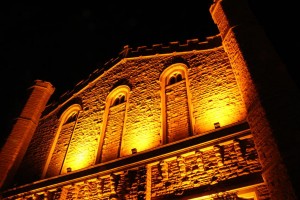With the Halloween craze now at its peak, questions arise about certain famous legends surrounding campus. But CU is a little less spooky than expected.
Perhaps one of the most common misconceptions about the campus is the existence of the underground tunnels, meshing into an intricate system that can be seen through the grates of storm drains at certain points in Boulder. Stories and rumors have surfaced that people who have ventured into the tunnels experience feelings of dread and ghostly chills.
As it turns out, this urban legend is just a bunch of hot steam, literally. The tunnels are just filled with miles upon miles of pipes and utility lines. Richard Trujillo, a steam fitter for the Facilities Management’s steam shop, gave insight into what actually goes down in the mysterious tunnels.
“We schedule preventive maintenance inspections on all the equipment [and] we inspect the integrity of the tunnels,” said Trujillo. “We are in the tunnel systems daily.”
Although the information as to where the tunnels lead and where their access points are is confidential, Trujillo did highlight prior experiences in dealing with students breaking and entering.
“In the past we have seen evidence of people in the tunnels that have put graffiti on the walls,” said Trujillo. “We do have the tunnel system secure. We do our very best to keep students out of the [tunnels], it is extremely dangerous. We have high pressure steam, high voltage electrics and even had quite a bit of asbestos.”
Another one of CU’s most storied myths: In 1966, tragedy struck when an organ player, Elaura Jacquette, befriended a janitor, Joseph Morse, and brought him to room 304 in Macky Auditorium late one night. The next day, she was discovered dead in the same room, and her body showed signs of sexual assault.
Campus historian Alan Cass was a lighting and sound technician at the time of Jacquette’s death.
Cass explained that Jacquette never befriended Morse, but met him on occasion at a museum Jacquette visited and where Morse worked. At 3 p.m. July 9, 1966, Morse lured Jacquette into room 304, where her body was discovered the next day.
“At the time the campus was pretty quiet and I think that’s why people assumed it happened at night,” Cass said. “It was 27 days before they actually apprehended the individual. He was turned in by his stepdaughter, who suspected that he was the person who committed the crime.”
Joseph Morse eventually confessed and died in prison in 2005. Since then, different variations of the story have sprung up, reaching such a level of sensationalism that Jacquette’s death has turned into a full-blown ghost story. Claims have been made that a ghostly woman can be seen roaming the halls of Macky and that loud organ music is played late at night when no one else is in the building.
Cassie Eron, an 18-year-old freshman dance major at CU, works as a stage hand at Macky Auditorium. She said the tale has become more urban legend than fact.
“The family of the victim had to live through all of this,” said Eron. “They didn’t want to make it public, but they put up a little plaque for her around the northwest side of campus. Then, this whole ghost story blew up and it’s incorrect. It’s disrespectful to the living family.”
According to Eron, the legend of Jacquette’s ghost has gained popularity and fame through Banjo Billy’s Bus Tour.
In 2008, Boulder paranormal specialists were called in to investigate any possible circumstances of a haunting. No substantial evidence was found after the paranormal team spent three and a half hours testing temperatures and recording EMF readings.
“There [are] no weird things that happen in Macky, but people just assume that some creepy things should happen because it’s a giant, ancient auditorium,” Eron said. “Out of the whole campus, it probably seems like the best place to have a ghost story.”
Contact CU Independent Staff Writer, Xandra McMahon at Xandra.mcmahon@colorado.edu.

